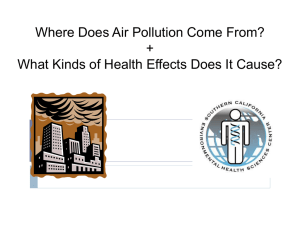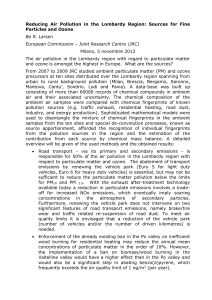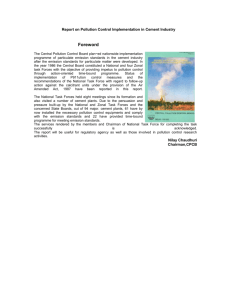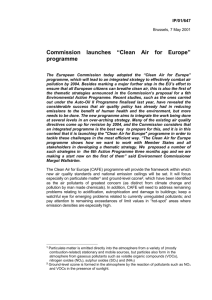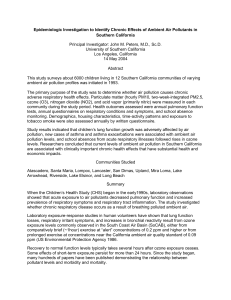Inhalation of Fine Particulate Air Pollution and Ozone Causes Acute
advertisement
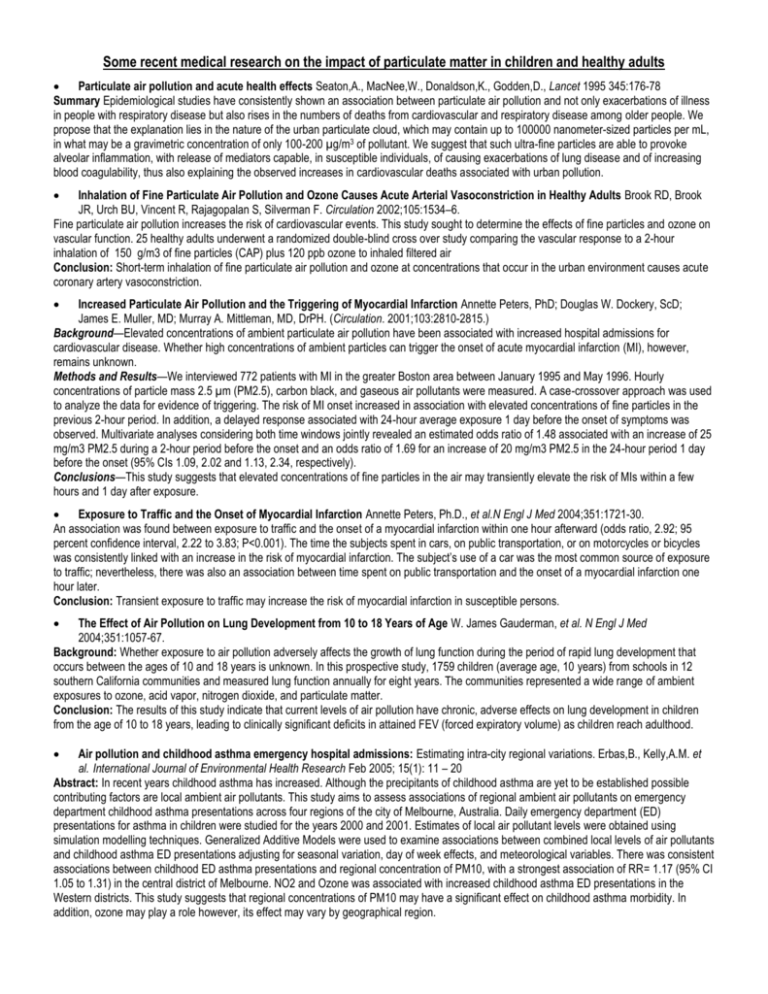
Some recent medical research on the impact of particulate matter in children and healthy adults Particulate air pollution and acute health effects Seaton,A., MacNee,W., Donaldson,K., Godden,D., Lancet 1995 345:176-78 Summary Epidemiological studies have consistently shown an association between particulate air pollution and not only exacerbations of illness in people with respiratory disease but also rises in the numbers of deaths from cardiovascular and respiratory disease among older people. We propose that the explanation lies in the nature of the urban particulate cloud, which may contain up to 100000 nanometer-sized particles per mL, in what may be a gravimetric concentration of only 100-200 µg/m3 of pollutant. We suggest that such ultra-fine particles are able to provoke alveolar inflammation, with release of mediators capable, in susceptible individuals, of causing exacerbations of lung disease and of increasing blood coagulability, thus also explaining the observed increases in cardiovascular deaths associated with urban pollution. Inhalation of Fine Particulate Air Pollution and Ozone Causes Acute Arterial Vasoconstriction in Healthy Adults Brook RD, Brook JR, Urch BU, Vincent R, Rajagopalan S, Silverman F. Circulation 2002;105:1534–6. Fine particulate air pollution increases the risk of cardiovascular events. This study sought to determine the effects of fine particles and ozone on vascular function. 25 healthy adults underwent a randomized double-blind cross over study comparing the vascular response to a 2-hour inhalation of 150 g/m3 of fine particles (CAP) plus 120 ppb ozone to inhaled filtered air Conclusion: Short-term inhalation of fine particulate air pollution and ozone at concentrations that occur in the urban environment causes acute coronary artery vasoconstriction. Increased Particulate Air Pollution and the Triggering of Myocardial Infarction Annette Peters, PhD; Douglas W. Dockery, ScD; James E. Muller, MD; Murray A. Mittleman, MD, DrPH. (Circulation. 2001;103:2810-2815.) Background—Elevated concentrations of ambient particulate air pollution have been associated with increased hospital admissions for cardiovascular disease. Whether high concentrations of ambient particles can trigger the onset of acute myocardial infarction (MI), however, remains unknown. Methods and Results—We interviewed 772 patients with MI in the greater Boston area between January 1995 and May 1996. Hourly concentrations of particle mass 2.5 µm (PM2.5), carbon black, and gaseous air pollutants were measured. A case-crossover approach was used to analyze the data for evidence of triggering. The risk of MI onset increased in association with elevated concentrations of fine particles in the previous 2-hour period. In addition, a delayed response associated with 24-hour average exposure 1 day before the onset of symptoms was observed. Multivariate analyses considering both time windows jointly revealed an estimated odds ratio of 1.48 associated with an increase of 25 mg/m3 PM2.5 during a 2-hour period before the onset and an odds ratio of 1.69 for an increase of 20 mg/m3 PM2.5 in the 24-hour period 1 day before the onset (95% CIs 1.09, 2.02 and 1.13, 2.34, respectively). Conclusions—This study suggests that elevated concentrations of fine particles in the air may transiently elevate the risk of MIs within a few hours and 1 day after exposure. Exposure to Traffic and the Onset of Myocardial Infarction Annette Peters, Ph.D., et al.N Engl J Med 2004;351:1721-30. An association was found between exposure to traffic and the onset of a myocardial infarction within one hour afterward (odds ratio, 2.92; 95 percent confidence interval, 2.22 to 3.83; P<0.001). The time the subjects spent in cars, on public transportation, or on motorcycles or bicycles was consistently linked with an increase in the risk of myocardial infarction. The subject’s use of a car was the most common source of exposure to traffic; nevertheless, there was also an association between time spent on public transportation and the onset of a myocardial infarction one hour later. Conclusion: Transient exposure to traffic may increase the risk of myocardial infarction in susceptible persons. The Effect of Air Pollution on Lung Development from 10 to 18 Years of Age W. James Gauderman, et al. N Engl J Med 2004;351:1057-67. Background: Whether exposure to air pollution adversely affects the growth of lung function during the period of rapid lung development that occurs between the ages of 10 and 18 years is unknown. In this prospective study, 1759 children (average age, 10 years) from schools in 12 southern California communities and measured lung function annually for eight years. The communities represented a wide range of ambient exposures to ozone, acid vapor, nitrogen dioxide, and particulate matter. Conclusion: The results of this study indicate that current levels of air pollution have chronic, adverse effects on lung development in children from the age of 10 to 18 years, leading to clinically significant deficits in attained FEV (forced expiratory volume) as children reach adulthood. Air pollution and childhood asthma emergency hospital admissions: Estimating intra-city regional variations. Erbas,B., Kelly,A.M. et al. International Journal of Environmental Health Research Feb 2005; 15(1): 11 – 20 Abstract: In recent years childhood asthma has increased. Although the precipitants of childhood asthma are yet to be established possible contributing factors are local ambient air pollutants. This study aims to assess associations of regional ambient air pollutants on emergency department childhood asthma presentations across four regions of the city of Melbourne, Australia. Daily emergency department (ED) presentations for asthma in children were studied for the years 2000 and 2001. Estimates of local air pollutant levels were obtained using simulation modelling techniques. Generalized Additive Models were used to examine associations between combined local levels of air pollutants and childhood asthma ED presentations adjusting for seasonal variation, day of week effects, and meteorological variables. There was consistent associations between childhood ED asthma presentations and regional concentration of PM10, with a strongest association of RR= 1.17 (95% CI 1.05 to 1.31) in the central district of Melbourne. NO2 and Ozone was associated with increased childhood asthma ED presentations in the Western districts. This study suggests that regional concentrations of PM10 may have a significant effect on childhood asthma morbidity. In addition, ozone may play a role however, its effect may vary by geographical region.


